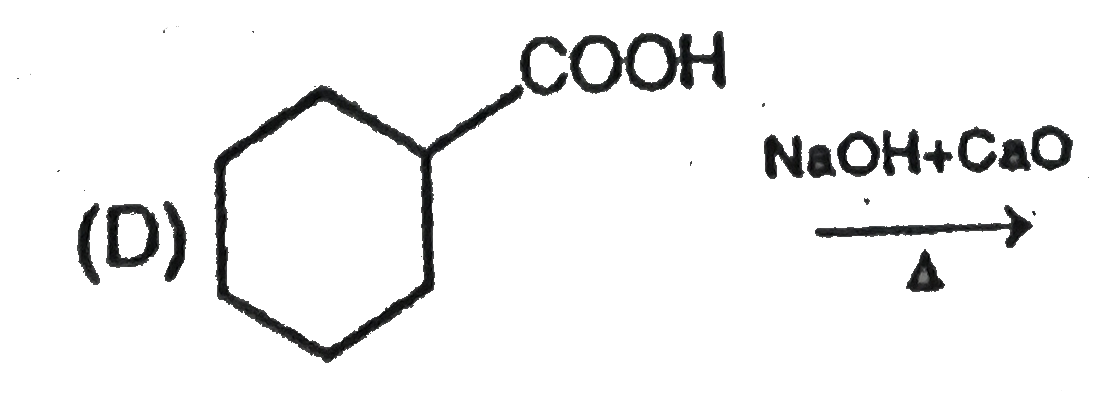Which of the following methods yield saturated hydrocarbon ?
R−CH=CH2BH3−−−−−−→CH3COOH
R−CH=CH2CH2N2,Δ−−−−−−→


The correct Answer is:A,B,C,D
To determine which of the following methods yield saturated hydrocarbons, we will analyze each option step by step.
Step 1: Analyze the first method
- Reaction: RCH=CH2 + BH3 + CH3COOH
- Process: The presence of BH3 (Boron Hydride) in the reaction with an alkene (RCH=CH2) and acetic acid (CH3COOH) leads to hydroboration. This process adds across the double bond, resulting in the formation of a saturated hydrocarbon.
- Product: The product formed is CH2-CH3, which is an alkane (saturated hydrocarbon).
Step 2: Analyze the second method
- Reaction: CH2N2 (Diazomethane) on heating
- Process: When CH2N2 is heated, it decomposes to form CH2 and nitrogen gas (N2). The CH2 can then react with another alkene (like CH2=CH2) to form a cyclopropane ring.
- Product: The product formed is a cyclopropane, which is also a saturated hydrocarbon.
Step 3: Analyze the third method
- Reaction: Na + ether with an alkene
- Process: The presence of sodium in ether can lead to the formation of a cyclopentane ring through a coupling reaction.
- Product: The product formed is cyclopentane, which is a saturated hydrocarbon.
Step 4: Analyze the fourth method
- Reaction: NaOH + CaO (heating) with a cycloalkane
- Process: When a cycloalkane undergoes a reaction with NaOH and CaO under heating, it can lead to the removal of CO2 and the formation of a cyclohexane ring.
- Product: The product formed is cyclohexane, which is also a saturated hydrocarbon.
Conclusion
All four methods yield saturated hydrocarbons. Therefore, the answer is that all options (1, 2, 3, and 4) yield saturated hydrocarbons.
---
- Reaction: RCH=CH2 + BH3 + CH3COOH
- Process: The presence of BH3 (Boron Hydride) in the reaction with an alkene (RCH=CH2) and acetic acid (CH3COOH) leads to hydroboration. This process adds across the double bond, resulting in the formation of a saturated hydrocarbon.
- Product: The product formed is CH2-CH3, which is an alkane (saturated hydrocarbon).
- Reaction: CH2N2 (Diazomethane) on heating
- Process: When CH2N2 is heated, it decomposes to form CH2 and nitrogen gas (N2). The CH2 can then react with another alkene (like CH2=CH2) to form a cyclopropane ring.
- Product: The product formed is a cyclopropane, which is also a saturated hydrocarbon.
- Reaction: Na + ether with an alkene
- Process: The presence of sodium in ether can lead to the formation of a cyclopentane ring through a coupling reaction.
- Product: The product formed is cyclopentane, which is a saturated hydrocarbon.
- Reaction: NaOH + CaO (heating) with a cycloalkane
- Process: When a cycloalkane undergoes a reaction with NaOH and CaO under heating, it can lead to the removal of CO2 and the formation of a cyclohexane ring.
- Product: The product formed is cyclohexane, which is also a saturated hydrocarbon.
All four methods yield saturated hydrocarbons. Therefore, the answer is that all options (1, 2, 3, and 4) yield saturated hydrocarbons.
Topper's Solved these Questions
Similar Questions
Knowledge Check
- Question 1 - Select One or More
Which of the following methods yield sturated hydrocarbon?
AR−CH=CH2BH3−−−−−−→CH3COOHBR−CH=CH2CH2N2−−−→ΔC D
D
- Question 2 - Select One
Which one of the following is a saturated hydrocarbon?
APropeneBPropyneCEtheneDButane - Question 3 - Select One
Which of the following is a saturated fatty acid?
AC11H23COOHBC15H31COOHCC17H31COOHDC17H35COOH
Which of the following is saturated hydrocarbon ?
View SolutionWhich of the following is unsaturated hydrocarbon?
View SolutionCatalytic hydrogenation of the following compound produces saturated hydrocarbon(s). The number of stereoisomer(s) formed is :
 View Solution
View SolutionWhich of the following yield maximum energy
View SolutionWhich of the following compounds will form hydrocarbon on reaction with Gridnard reagent ?
View Solution

